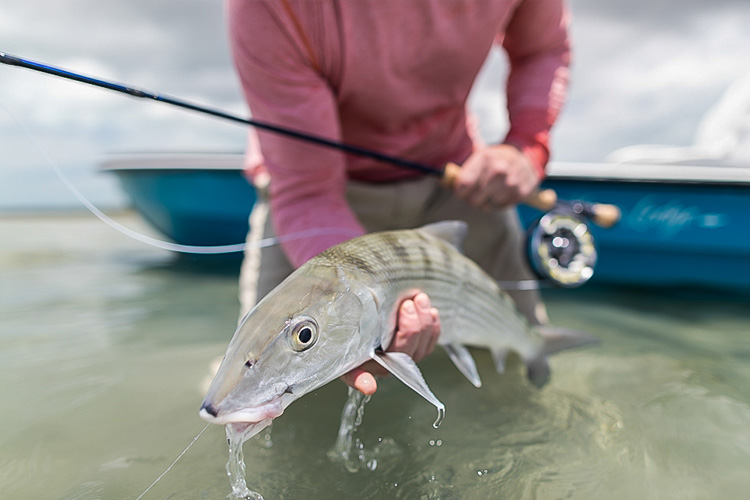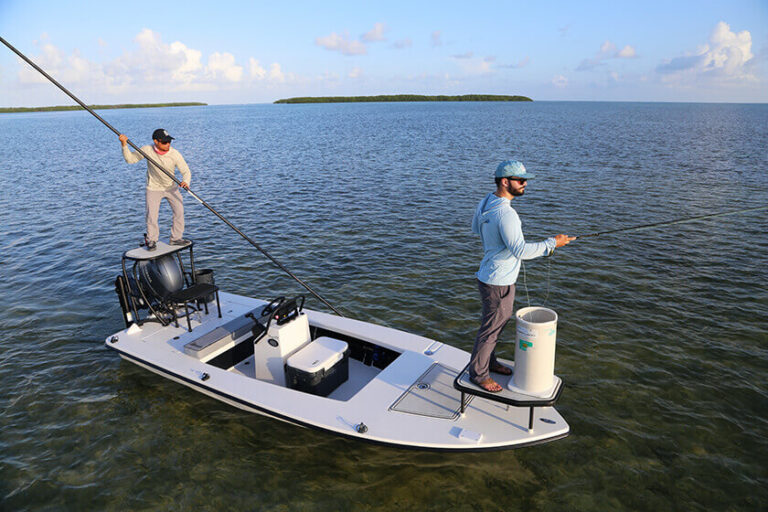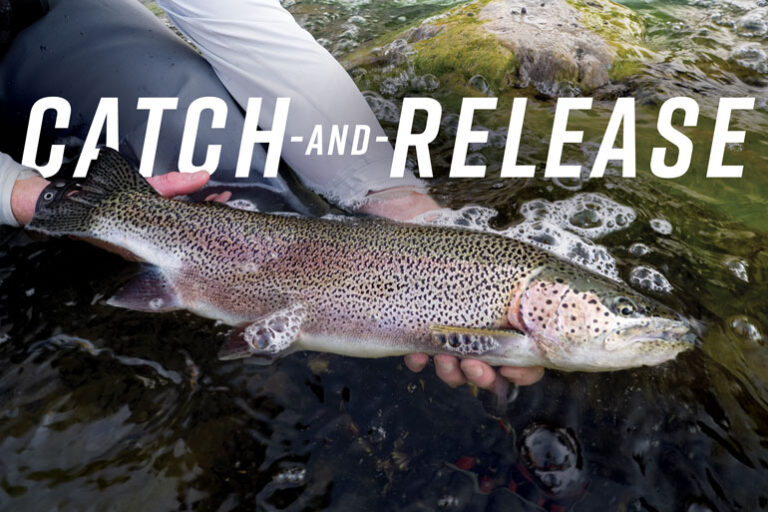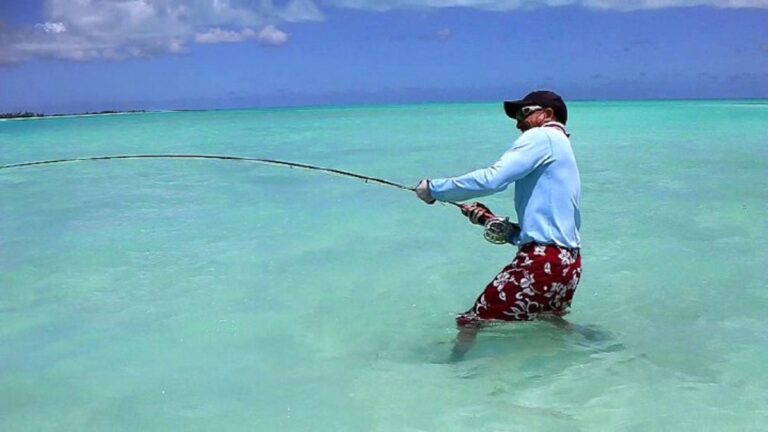The best times for flats fishing are early morning and late afternoon. Flats fishing enthusiasts are likely to have the most success during the early morning and late afternoon hours.
These times are particularly favorable due to factors such as cooler water temperatures, less boat traffic, and a higher likelihood of fish activity. Early mornings often provide calm and glassy conditions, making it easier to spot fish on the flats.
As the day progresses, temperatures rise and wind picks up, making fishing more challenging. However, as evening approaches, the water starts to cool down again, making it another prime time for flats fishing. It is important to note that these are general guidelines, and fishing conditions can vary depending on factors such as location, weather patterns, and the species being targeted. Overall, being on the water during the early morning and late afternoon gives anglers a better chance of success in this exciting form of fishing.

Credit: drifthook.com
Understanding Flats Fishing: A Brief Introduction
Flats fishing is a thrilling and popular angling technique that involves targeting fish in shallow areas of water known as flats. These flats can be found in various locations, including coastal regions, lagoons, and even freshwater environments. Understanding the basics of flats fishing is crucial for any angler looking to have a successful and enjoyable experience on the water.
Explanation Of What Flats Fishing Is
- Flats fishing involves targeting fish in shallow waters, typically with light tackle and fly fishing gear.
- Anglers navigate the flats on specialized skiffs or boats designed to access shallow areas.
- The goal is to spot fish, such as bonefish, redfish, tarpon, or permit, and present a well-placed lure or fly in their path.
Importance Of Understanding The Best Times For Flats Fishing
- The success of flats fishing largely depends on timing, as there are certain times of the day that are more productive than others.
- Knowing the best times to fish the flats can increase your chances of encountering actively feeding fish and improve your overall fishing experience.
- Fishing during optimal time windows can result in more opportunities to catch trophy-sized fish and maximize your time on the water.
Overview Of The Factors That Influence Fishing Conditions
- Tide: The movements of the tides have a significant impact on flats fishing. Understanding the tide patterns and fishing during incoming or outgoing tides is essential.
- Light: The angle and intensity of sunlight can affect fish behavior. Fishing during low light conditions, such as early morning or late afternoon, is often ideal.
- Water temperature: Fish are ectothermic creatures, meaning their body temperature depends on external conditions. Flats fishing is most productive when water temperatures are within the preferred range of the targeted species.
- Wind: Wind can impact the visibility of fish and make casting more challenging. Fishing the leeward side of flats or sheltered areas can help mitigate the effects of strong winds.
- Seasonal patterns: Different species exhibit seasonal migrations and behaviors. Understanding these patterns can help determine the best times to target specific fish species on the flats.
By familiarizing yourself with the basics of flats fishing and the factors that influence fishing conditions, you can greatly enhance your chances of success on the water. Remember, observing and adapting to the unique characteristics of each fishing location will also play a vital role in your overall angling experience.
So grab your gear, get out on the flats, and enjoy the thrill of this exhilarating type of fishing!
Morning Glory: Prime Time For Flats Fishing
The early morning hours offer some of the best opportunities for flats fishing. If you’re an avid angler or looking to embark on a fishing adventure, setting your alarm clock a bit earlier may lead to a bountiful catch. Let’s dive into the advantages of fishing in the morning, the impact of temperature on fish behavior, water clarity considerations, and essential tips for maximizing your catch during the morning bite.
Exploring The Advantages Of Fishing In The Morning
- Peaceful and serene atmosphere: Early morning hours provide a tranquil environment with minimal disturbances. As you set out on the water, you’ll have the flats all to yourself, giving you the best chance to enjoy the serenity and connect with nature.
- Optimal fish activity: Fish are more active during the morning hours, making it an ideal time for flats fishing. They are more likely to be searching for food and will be eager to strike. Take advantage of their heightened activity levels for a successful day on the water.
Temperature, Water Clarity, And Fish Behavior In The Early Hours
- Cooler temperatures: The morning hours offer cooler temperatures, which can have a positive impact on fish behavior. Fish tend to be more active in comfortable water temperatures, increasing your chances of landing a prized catch.
- Better water clarity: At sunrise, the water tends to be clearer and less disturbed by boat traffic and other activities. Improved water clarity allows you to spot fish more easily, leading to more accurate casts and increased chances of attracting bites.
Tips For Maximizing Your Catch During The Morning Bite
- Arrive early: Aim to reach your fishing destination before sunrise to capitalize on the prime time for flats fishing. This will give you ample time to set up and prepare for the morning bite.
- Experiment with different baits: Fish may have varying preferences for bait depending on the time of day. In the morning, try using live bait or lures that mimic the natural prey species prevalent during this time. Experimenting with different baits can help you understand which ones are most effective during the morning bite.
- Focus on shallow areas: During the morning hours, fish are frequently found in shallower waters. Focus your efforts on flats, shallow reefs, or grassy areas where fish tend to gather in search of food.
- Make precise casts: With the improved visibility in the morning, accuracy is vital. Take your time to make precise casts and target specific areas where fish are likely to be present. This will increase your chances of enticing a strike.
- Stay patient and adaptable: Fishing is an art that requires patience and adaptability. Some mornings may yield abundant catches, while others may be slower. Stay patient, observe the water conditions, and be willing to adapt your techniques if needed.
By taking advantage of the morning glory in flats fishing, you can set yourself up for a successful day on the water. Enjoy the peaceful atmosphere, leverage the advantages of early hours, and follow the tips provided to maximize your chances of landing a remarkable catch during the morning bite.
Happy fishing!
Afternoon Adventures: Overcoming Challenges
Fishing in the afternoon can present a unique set of conditions and challenges. As the sun reaches its peak and the tide changes, anglers need to adapt their strategies to continue their successful flats fishing expedition. To make the most of your afternoon adventure, here are some strategies and techniques to consider:
Discussing The Unique Conditions And Challenges Of Fishing In The Afternoon
Fishing in the afternoon may not be as popular as early morning trips, but it offers its own rewards. Understanding the unique conditions and challenges can help you adapt and make the most of your time on the water. Here are some key points to consider:
- Increased sunlight: The afternoon sun can be intense, causing fish to seek shelter or move to deeper water. Adjusting your approach to account for brighter conditions can yield better results.
- Changing tide patterns: Tides play a crucial role in fish behavior, and in the afternoon, the tide may be transitioning from high to low or vice versa. Understanding how these changes affect feeding patterns can help you pinpoint the ideal spots to target.
- Shifts in wind direction: Afternoon winds tend to pick up, making it important to adjust your casting techniques. Wind against tide can create challenging casting conditions, but it can also concentrate baitfish and make certain areas more productive.
Strategies For Adapting To Changing Sunlight, Tide, And Winds
Adapting to the changing conditions of the afternoon requires flexibility and a strategic approach. Here are some strategies to help you overcome the challenges of sunlight, tide, and winds:
- Choosing the right flies or lures: Opt for lures or flies that imitate baitfish commonly found in your fishing location. Brightly colored patterns or those with reflective properties can be more visible in the afternoon light.
- Varying your retrieve: Experiment with different retrieve speeds and depths to find the most effective technique for enticing fish. Fish may be more sluggish in the afternoon, so a slower retrieve can often be more successful.
- Understanding fish behavior: Spend time observing the water and fish movements. Look for signs of feeding activity, such as baitfish jumping or birds diving, which can indicate where the fish are congregating.
- Targeting shaded areas: As the sun gets higher in the sky, fish seek refuge in shaded areas such as mangroves, overhangs, or structures. Casting in these areas can increase your chances of enticing a strike.
- Optimizing your casting: Adjust your casting angle to account for wind direction and tide movement. Casting upwind or against the tide can provide a more natural presentation and increase your chances of success.
Techniques For Finding And Enticing Fish During The Midday Lull
The midday lull can be a challenging period for flats fishing, but with the right techniques, you can still find and entice fish. Here are some techniques to consider:
- Exploring deeper spots: As the day progresses, fish may move to deeper channels or holes to escape the midday heat. Targeting these areas can result in more action and better chances of hooking a fish.
- Focusing on structure: Search for structures such as grass beds, oyster bars, or drop-offs that provide fish with relief from the heat. These areas can concentrate fish and increase your chances of success.
- Switching to subsurface flies or lures: If fish are not actively feeding on the surface, try using subsurface flies or lures to target deeper-holding fish. Slowly retrieve the fly or lure to imitate a wounded baitfish, enticing a strike.
- Being patient and observant: Midday fishing requires patience and attentiveness. Keep an eye out for any signs of activity or movement in the water. Be cautious with your approach to avoid spooking fish in the shallower areas.
Remember, while the afternoon may present its challenges, it also offers unique opportunities for flats fishing. By adapting your strategies and techniques to the changing conditions of sunlight, tide, and winds, you can overcome the challenges and have a successful and rewarding fishing adventure.
So, gear up and get ready to explore the flats during the afternoon hours!
Twilight Triumphs: The Evening Bite
As the sun begins to set, a whole new world of fishing opportunities emerges. The twilight hours, with their magical blend of fading light and calm waters, hold immense potential for avid flats fishermen. Whether you’re a seasoned angler or a beginner, the evening bite can provide an exhilarating and fruitful fishing experience.
Let’s dive into why the twilight hours are ideal for flats fishing and some tips to make the most out of this enchanting time of day.
Highlighting The Opportunities Presented By Fishing In The Evening
- Abundance of prey: During twilight, many species of baitfish gather near the flats, attracting larger predatory fish. This increase in prey activity enhances the chances of a successful catch.
- Energetic fish: Fish tend to be more active during the evening bite, making them more inclined to strike at your bait. You can take advantage of their heightened activity levels to increase your chances of landing a trophy fish.
- Peaceful surroundings: The evening hours often bring stillness and tranquility to the flats. With less boat traffic and fellow anglers, you’ll have a greater chance of enjoying a more peaceful and undisturbed fishing experience.
- Stunning sunsets: Watching the sky transform into a canvas of vibrant colors as the sun sets is an added bonus to your fishing trip. The celestial beauty of a sunset can enhance the overall experience and create cherished memories.
Factors That Make The Twilight Hours Ideal For Flats Fishing
- Optimal visibility: During twilight, the decreasing light levels create ideal visibility conditions for both anglers and fish. The glare from the sun is diminished, allowing you to spot fish movement and easily assess the flats’ features.
- Cooler temperatures: The temperature during the evening bite is often more comfortable compared to the scorching heat of the midday sun. This makes the fishing experience more enjoyable and can enhance your focus on the task at hand.
- Feeding behavior: Nocturnal and crepuscular species become more active as daylight diminishes. This ensures that predator fish are on the hunt, actively searching for their next meal. Take advantage of their feeding behavior and entice them with well-presented bait.
Tips For Successful Fishing During Twilight And Sunset
- Choose the right flies or lures: During the evening bite, consider using darker-colored flies or lures to mimic the prevailing low-light conditions. Opt for patterns that imitate the baitfish prevalent in the area you are fishing.
- Cast strategically: Take advantage of the fading light and cast your bait towards structure, such as mangroves or submerged rocks, where predatory fish tend to seek refuge and ambush their prey.
- Vary your retrieves: Experiment with different retrieve speeds, pausing intermittently to mimic injured or struggling prey. This variability can entice fish and trigger strikes, especially during the twilight hours.
- Be prepared with lighting: As darkness descends, it is crucial to have proper lighting to navigate safely and efficiently. Carry a headlamp or flashlight to ensure your own safety and to assist with handling your gear and tying knots.
- Practice catch and release: Preserve the flats’ delicate ecosystem by releasing any fish you do not intend to keep. This contributes to the continued sustainability and conservation of the flats fishery.
The twilight hours hold immense promise for flats fishing enthusiasts. By understanding the unique opportunities presented during this time, adapting your techniques accordingly, and being prepared, you can greatly increase your chances of a successful and memorable fishing expedition. So, grab your gear, embrace the beauty of the twilight, and get ready for a thrilling evening on the flats!
Conclusion
Fishing enthusiasts are constantly chasing the perfect flats fishing experience, and understanding the best times of the day for this activity is invaluable. By analyzing various factors such as tide, weather, and sun position, it becomes clear that early morning and late afternoon are prime times for flats fishing.
During these periods, cooler water temperatures and lower light intensity attract fish to the shallows, increasing your chances of a successful catch. Additionally, avoiding midday when the sun is at its highest and the heat is most intense ensures a more comfortable and productive fishing trip.
However, it’s important to keep in mind that these suggestions are not set in stone, as fish behavior and availability can vary depending on location and season. Don’t hesitate to consult with local experts or experienced anglers for personalized insights.
With careful planning and some luck, you can optimize your flats fishing experience and create unforgettable memories on the water. Happy fishing!




